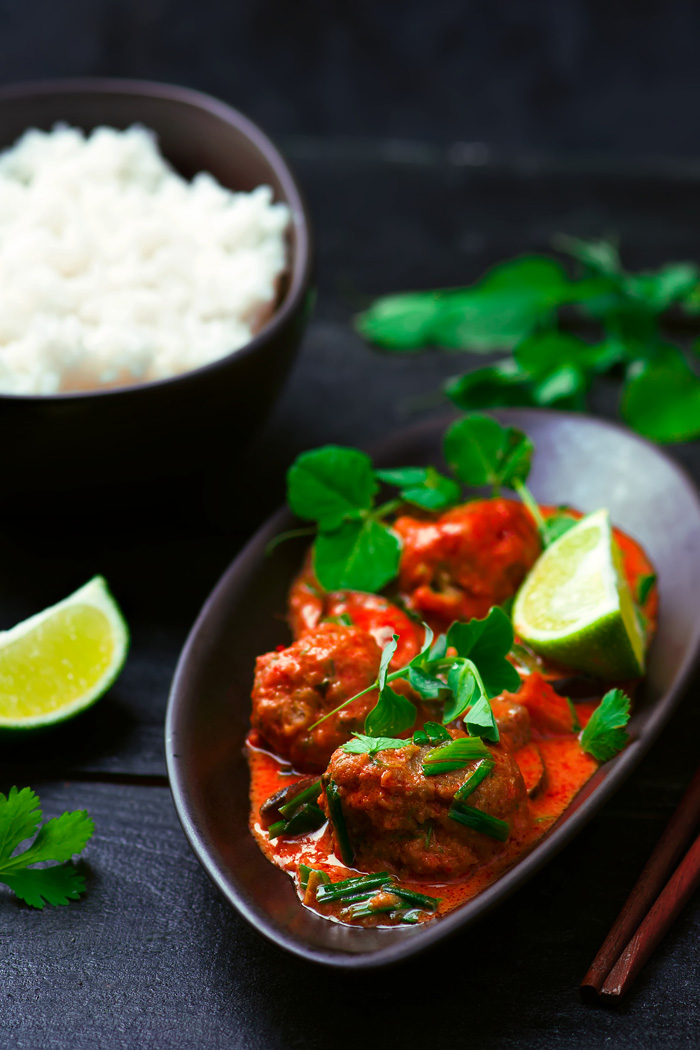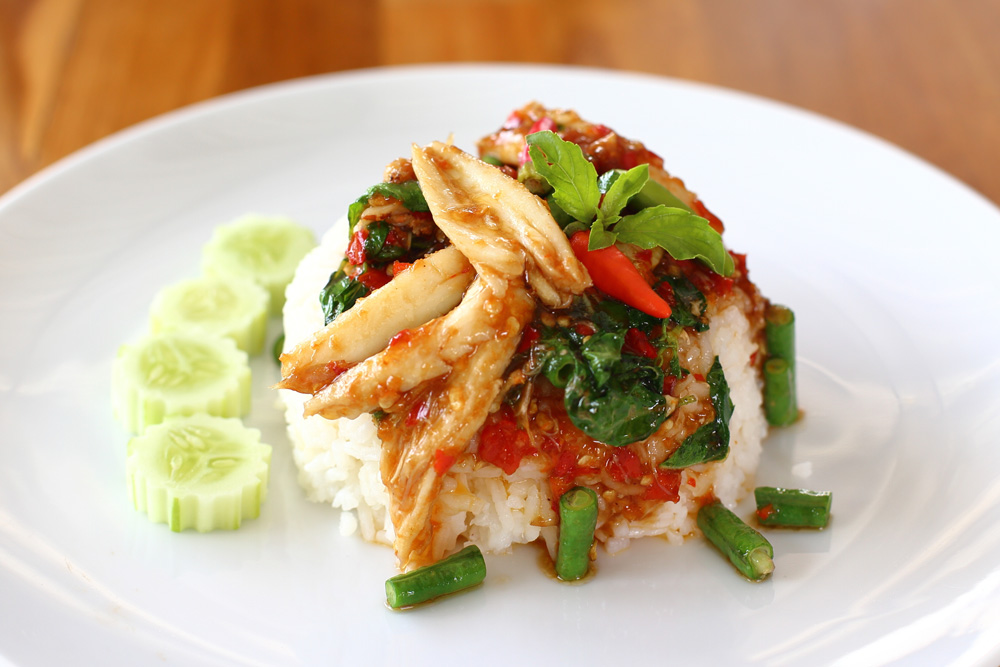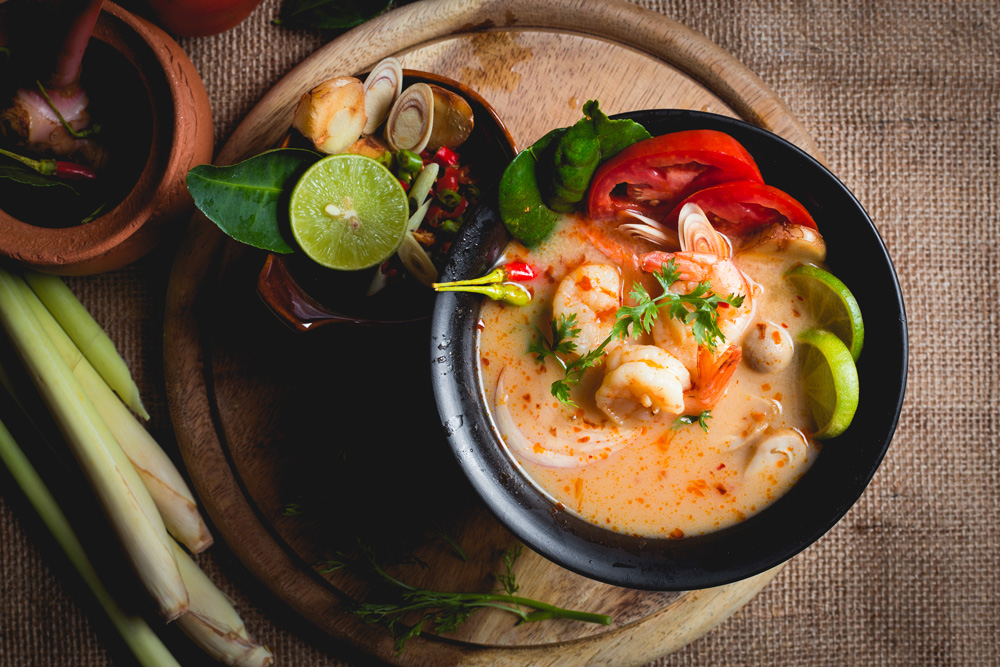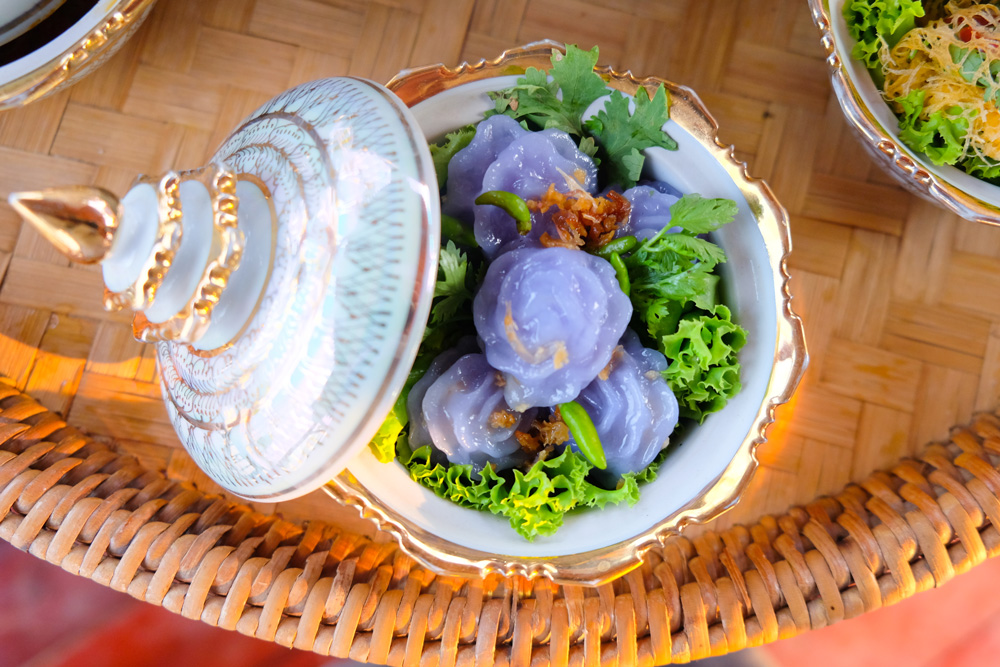Thai cuisine – a balance of flavours incorporating the five opposing essences of sour, sweet, spicy, bitter and salty, from curries to stir-fry, harmony is the guiding principle behind each dish

Thai cuisine, one of the most popular cuisines in the world, a simple yet clever combination of Eastern and Western influences harmoniously combined by sour, sweet, salty, bitter and spicy flavours which will work together to make each dish come alive. Thai food varies depending upon the area or region of Thailand from which the dish originates. These regions include the north, northeast, south and central. Historically, shellfish and fish, as well as plants and herbs, were popular ingredients, large quantities of meat were avoided, in part due to the Buddhist background of Thailand, but also because they were a luxury item. Strips of meat were added to other ingredients after being flavoured with herbs and spices, or else meat was cooked or roasted and then shredded.
Traditional Thai cookery involved stewing and baking, or grilling. However, the area that is now Thailand, Laos, Burma (Myanmar), Cambodia and Vietnam were settled by the ancient Chinese an estimated 1,400 years ago. With the migration of Chinese people into Southeast Asia, frying, stir-frying and deep-frying of food became more popular techniques, and to this day pad thai (fried noodles) and khao pad (fried rice) remain classic Thai dishes.
Other culinary influences from the 17th century onwards included Portuguese, Dutch, French and Japanese. Chillies initially came to Thailand during the late 1600s with the Portuguese missionaries, who had taken a liking to the fiery ingredient in South America. Thais are well known for their commitment and resourcefulness, and even in cookery they were adept at replacing ingredients – for example the ghee used in Indian cooking was replaced by coconut oil, and coconut milk. Thai food used to be a lot spicier than it is now, but over the years it was toned down, and fewer and less spices were used in curries, while the use of fresh herbs, such as lemon grass and galangal, increased. Thai cuisine is more accurately described as four regional cuisines, corresponding to the four main regions of the country.
Central Thai cuisine from the flat and wet central rice-growing plains as well as Bangkok features Ahan Phak Klang which is most often eaten with non-glutinous jasmine rice. The cuisine has also incorporated many Thai Chinese dishes. Specialities include Chuchi pla kaphong - snapper in chuchi curry sauce (thick red curry sauce), Kai phat khing - chicken stir fried with sliced ginger, Kaeng khiao wan - called “green curry” in English. This is a coconut curry made with fresh green chillies and flavoured with Thai basil, and chicken or fish meatballs. This dish can be one of the spiciest of Thai curries. Hor mok pla - a pâté or soufflé of fish, spices, coconut milk and egg, steamed in a banana leaf cup and topped with thick coconut cream before serving. Kaeng phet (spicy curry) - also known as red curry in English, is a coconut curry made with copious amounts of dried red chillies in the curry paste; and Kaeng som - a hot and sour soup/curry usually eaten together with rice.
The extremely popular tom yam hot and sour soup with meat comes from this region, with shrimp it is called tom yam goong or tom yam kung, with seafood (typically shrimp, squid, fish) tom yam thale, with chicken tom yam kai.
North-eastern Thai cuisine from the more arid Khorat Plateau, similar in culture to Laos, also influenced by Khmer cuisine from Cambodia, and by Vietnamese cuisine. The staple food of Isaan is glutinous rice, the food is spicy and cooked with local ingredients. Isaan people primarily get their income from farming, crops include rice, sugar cane, pineapple, potato, and rubber. Northern Thai cuisine from the verdant valleys and cool, forested mountains of the Thai highlands, this area was once ruled by the former Lanna Kingdom and is home to the majority of the ethnic groups of Thailand. The dishes are influenced by Burma, northern Laos, and the Yunnan Province in China.
Glutinous rice is eaten as the staple food with specialities including Aep - a slow-grilled meat, small fish or edible insects which are wrapped in banana leaves and mixed with beaten eggs and spices. Kaeng hang-le - a Burmese-influenced stewed pork curry which uses peanuts, dried chillies, tamarind juice and curry paste in the recipe, but containing no coconut milk and Kaeng khae - a spicy northern Thai curry of herbs, vegetables, the leaves of an acacia tree (chaom) and meat (chicken, water buffalo, pork or frog).
Southern Thai cuisine from the Kra Isthmus, which is bordered on two sides by tropical seas, has many dishes that contain liberal amounts of coconut milk and fresh turmeric, in common with Indian, Malaysian, and Indonesian cuisine and like them they eat non-glutinous rice as their staple food. Specialities are Kaeng matsaman - also known as Massaman curry, usually made by Thai-Muslims, of stewed beef and containing roasted dried spices, such as coriander seed, that are rarely found in other Thai curries. Massaman was ranked number one in an article titled World’s 50 most delicious foods. Kaeng tai pla – a thick sour vegetable curry made with turmeric and shrimp paste, often containing roasted fish or fish innards, bamboo shoots, and eggplant.
Khao mok - Thai-style biryani, a specialty of southern Thailand’s Muslim community and Khua kling - a very dry spicy curry made with minced or diced meat with sometimes yard long beans added to it; often served with fresh green phrik khi nu (Thai chilies) and copious amounts of finely shredded bai makrut (kaffir lime leaves).

In addition to these four regional cuisines, there is also the Thai royal cuisine which can trace its history back to the cosmopolitan palace cuisine of the Ayutthaya kingdom (1351–1767). Its refinement, cooking techniques, presentation, and use of ingredients were of great influence in the cuisine of the central Thai plains.
Many dishes now popular in Thailand were originally Chinese dishes. They were introduced to Thailand by the Hokkien people in the 15th century, and by the Teochew people who settled in large numbers in the late 18th century, and now form the majority of the Thai Chinese. These dishes include choke Thai (rice porridge, salapao (steamed buns), kuaitiao rat na (fried rice-noodles) and khao kha mu (stewed pork with rice). The Chinese also introduced the use of a wok for cooking, the technique of deep-frying and stir frying and several types of noodles, fermented bean paste, soy sauces, and tofu. The cuisines of India and Persia, brought first by traders, and later settlers from these regions, with their use of dried spices, gave rise to Thai adaptations.
Thai food was traditionally eaten with the right hand while seated on mats or carpets on the floor as still happens in the more traditional households. It is now generally eaten with a fork and spoon. Despite China having such an influence on both the country and the food, chopsticks are rarely used, even when eating noodles.

Thai cuisine only became well-known worldwide from the 1960s onwards, when Thailand became a destination for international tourism and American troops arrived in large numbers during the Vietnam War period. The global popularity of Thai cuisine is seen as an important factor in promoting tourism to Thailand, and is also an important factor in increasing Thailand’s agricultural exports.
The quality and choice of street food in Thailand is now world-renowned. Bangkok is often mentioned as one of the best street food cities in the world, and even called the street food capital of the world. There is scarcely a Thai dish that is not sold by a street vendor or at a market somewhere in Thailand. The foods that are made to order, tend to be dishes that can be quickly prepared: quick stir fries with rice, such as kaphrao mu (spicy basil-fried minced pork) or phat khana (stir fried gailan), and quick curries such as pladuk phat phet (catfish fried with red curry paste).
Noodles are a popular street food item as they are mainly eaten as a single dish. Chinese-style noodle soups, fried noodles, and fermented Thai rice noodles (khanom chin), served with a choice of different Thai curries is popular. Nearly everywhere in Thailand you will see som tam (green papaya salad) and sticky rice sold at stalls and roadside shops. This is popularly eaten together with grilled chicken. In most cities and towns there will be stalls selling sweet roti, a thin, flat fried dough envelop, with fillings such as banana, egg, and chocolate. The roti is similar to the Malay roti canai and Singaporean roti prata, and the stalls are often operated by Thai Muslims. Sweets snacks, collectively called khanom, such as tako (coconut cream jelly), khanom man (coconut cassava cake), and khanom wun (flavoured jellies), can be seen displayed on large trays in glass covered push-carts.
Food markets in Thailand, large open air halls with permanent stalls, tend to operate as a collection of street stalls, each vendor with their own set of tables and providing limited service. Food courts and food markets offer many of the same foods as street stalls, both pre-cooked as well as made to order. Night food markets, in the form of a collection of street stalls and mobile vendors, spring up in parking lots, along busy streets, and at temple fairs and local festivals in the evenings, when the temperatures are more agreeable and people have finished work.
Due to the fact that many dishes are similar to those that people would cook at home, it is a good place to find regional and seasonal foods.
